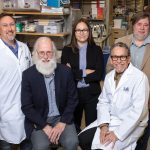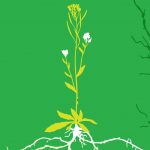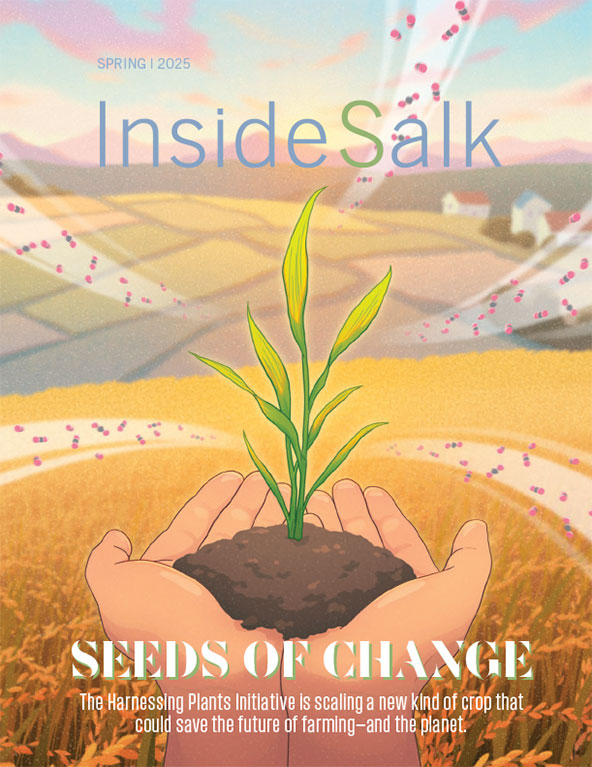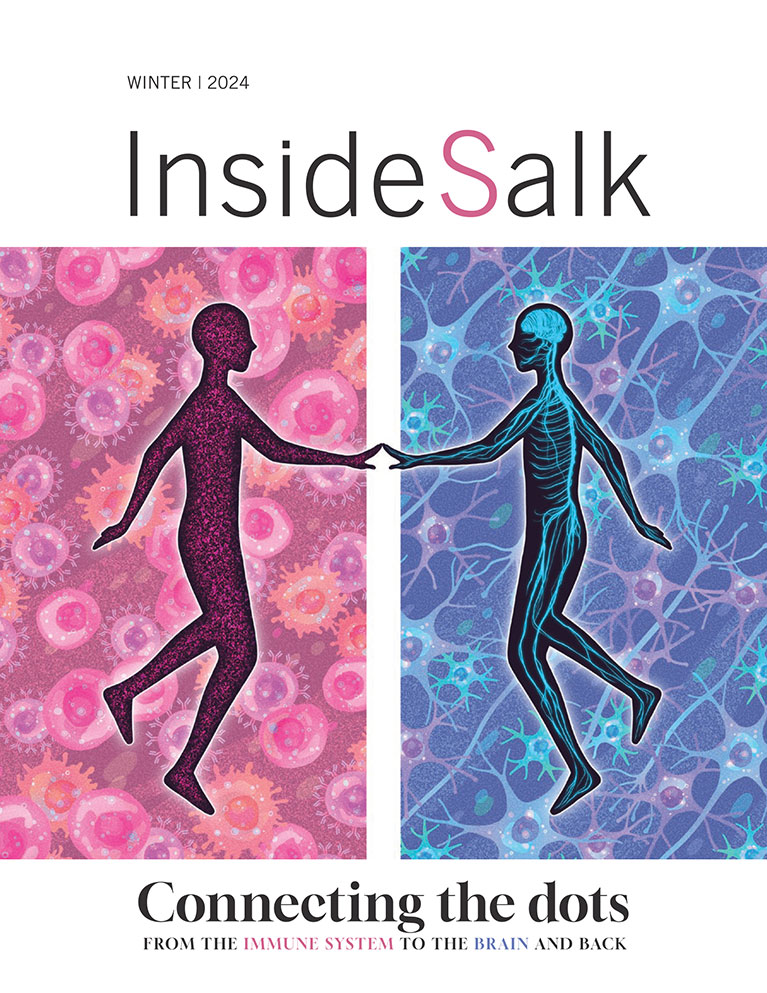Brain cells called astrocytes play a key role in helping neurons develop and function properly, but there’s still a lot scientists don’t understand about how astrocytes perform these important jobs. Now, Associate Professor Nicola Allen and colleagues have found one way that neurons and astrocytes work together to form healthy connections called synapses. This insight into normal astrocyte function could help scientists better understand disorders linked to problems with neuronal development, including autism spectrum disorders.
Read News ReleaseDiscoveries
Long-lived proteins in brain mitochondria stabilize protein complexes
Mitochondria are known as the powerhouses of the cell, generating the energy that’s needed to fuel the functions that our cells carry out. Senior Vice President and Chief Science Officer Martin Hetzer, first author Shefali Krishna and colleagues have taken a closer look at how mitochondria are maintained in nondividing cells, such as neurons. The researchers found that many of the proteins in mitochondria last much longer than expected, and that this stability likely protects them from damage. These findings will ultimately help researchers better understand age-related diseases, such as Alzheimer’s disease, and offer insights on treatment and prevention
Read News ReleaseHow injury to the pancreas influences cancer development
In a study led by Professor Geoffrey Wahl and Vanderbilt Assistant Professor Kathy DelGiorno, first author Zhibo Ma and colleagues found that cells in the pancreas form new cell types to mitigate injury, but then become susceptible to cancerous mutations. Their findings establish a better understanding of the pancreas’ healing mechanisms and offer insights into what happens when the process goes awry. Targeting these processes may lead to new treatments for patients with pancreatitis and pancreatic cancer.
Read News ReleaseWhich side is which: How the brain perceives borders
Professor John Reynolds and Senior Postdoctoral Fellow Tom Franken have discovered that neurons deep in the brain’s cortex are the first to compute which side of a visual border is an object versus a background. Through recording the activity of neurons in different layers of the cortex, the scientists were able to determine which particular cells were processing this border. Their discovery helps reveal how neurons communicate to supply us with internal representations of the external world. This work also provides researchers with better tools for diagnosing and treating brain disorders, such as schizophrenia.
Read News ReleaseReading the mind of a worm
Associate Professor Sreekanth Chalasani and colleagues have found a way to look at the brain activity of a worm and tell you which chemical the animal smelled a few seconds before. It sounds like a party trick, but these findings help scientists better understand how the brain functions and integrates information. The goal, of course, isn’t to read the minds of worms, but to gain a deeper understanding of how humans encode information in the brain. These findings help scientists unravel what happens when this encoding goes awry in sensory processing disorders and related conditions, such as anxiety, ADHD and autism spectrum disorders.
Read News ReleaseStudy shines a light into “black holes” in the Arabidopsis genome
Research Professor Todd Michael and colleagues sequenced the genome of the world’s most widely used model plant species, Arabidopsis thaliana, revealing new information about a region of its chromosomes called the centromere. The findings provide insights into centromere rapid evolution and the genomic equivalent of black holes. With this approach, scientists will be able to map centromeres from diverse Arabidopsis species, and ultimately more widely throughout plants.
Read News ReleaseSecrets of quillwort photosynthesis could boost crop efficiency
The humble quillworts are an ancient group of approximately 250 small, aquatic plants that have largely been ignored by modern botanists. While most plants breathe in carbon dioxide (CO2) during the day, quillworts breathe in CO2 at night. Now, Research Professor Todd Michael and colleagues have sequenced the first quillwort genome to uncover new insights related to the plant’s unique method of photosynthesis. Their discoveries could eventually lead to the engineering of crops that address climate change through more efficient water use and carbon capture.
Read News ReleaseImproving drug options for colorectal cancer patients
A major issue in cancer medicine is matching patients with effective treatments. Although patients with colorectal cancer were among the first to receive targeted therapies, many were ineligible, as their cancer-promoting mutations were believed to cause resistance to certain drugs. Assistant Professor Edward Stites and first author Thomas McFall paired computational models and experimental data and discovered that up to 12,000 additional colon cancer patients could benefit from an existing class of targeted therapies. They hope that clinical trials will highlight the magnitude of these findings and motivate more research on these mutations.
Read News ReleasePain and anxiety impact breathing on a cellular level
You’re startled by a threatening sound, and your breath quickens; you smash your elbow and pant in pain. Why a person’s breathing rate increases dramatically when they’re hurting or anxious was not previously understood. Now, Assistant Professor Sung Han, first author Shijia Liu and colleagues have uncovered a neural network in the brain that coordinates breathing rhythm with feelings of pain and fear. The findings contribute to the fields of pain management and psychological theories of anxiety. What’s more, the study could lead to development of an analgesic that prevents opioid-induced respiratory depression, the disrupted breathing that causes overdose deaths. See Analysis feature.
Read News ReleaseA new route for regulating blood sugar levels independent of insulin
The discovery of insulin 100 years ago opened a door that would lead to life and hope for millions of people with diabetes. Since then, insulin, produced in the pancreas, has been considered the primary means of treating conditions characterized by high blood glucose, such as diabetes. Now, Professor Ronald Evans, first author Gencer Sancar and colleagues have discovered a second molecule called FGF1 that is produced in fat tissue and, like insulin, also potently and rapidly regulates blood glucose. Their finding could lead to the development of new diabetes therapies, and also lays the foundation for promising new avenues in metabolism research.
Read News ReleasePlants rely on the CLASSY gene family to diversify their epigenomes
What determines how a cell’s genome is regulated to ensure proper growth and development? Turns out, the parts of the genome that are turned on or off in each cell-type or tissue play a major role in this process. Now, Associate Professor Julie Law, first author Ming Zhou and colleagues have shown that the CLASSY gene family regulates which parts of the genome are turned off in a tissue-specific manner. The discovery has the potential to advance many areas in biology, from boosting crop yields in plants to enhancing the efficacy of medical treatments for humans.
Read News ReleaseActive ingredient in cannabis protects aging brain cells
Decades of research on medical cannabis has focused on the compounds THC and CBD in clinical applications. But less is known about the therapeutic properties of cannabinol. This molecule is derived from the cannabis plant, is molecularly similar to THC, but is not psychoactive. Now, Research Professor Pamela Maher, first author Zhibin Liang and colleagues have found that cannabinol can protect nerve cells from oxidative damage, a major pathway to cell death. The discovery suggests that cannabinol has the potential to treat age-related neurodegenerative diseases, such as Alzheimer’s disease.
Read News ReleaseIn a first for “sonogenetics,” researchers control mammalian cells with sound
Clinicians treating brain disorders such as Parkinson’s disease and epilepsy currently use deep brain stimulation, a process that involves surgically implanting electrodes in the brain, to activate certain subsets of cells. Now, Associate Professor Sreekanth Chalasani, co-first authors Marc Duque, Corinne Lee-Kubli and Yusuf Tufail, and colleagues have pinpointed a sound-sensitive mammalian protein that lets them activate brain cells with ultrasound. Pioneered by Chalasani, “sonogenetics” uses ultrasonic waves to stimulate specific groups of genetically marked cells. The finding paves the way toward non-invasive versions of deep brain stimulation, pacemakers and insulin pumps. See Resolution feature.
Featured Stories
 The Salk Institute and Lustgarten Foundation form strategic pancreatic cancer research partnershipSupported by a $5 million grant, the partnership aims to identify and validate potential targets for new pancreatic cancer drugs. Four participating labs, led by Salk Professors Reuben Shaw, Ronald Evans, Tony Hunter and Assistant Professor Dannielle Engle, will bring their individual areas of complementary expertise to bear on the collaborative goal.
The Salk Institute and Lustgarten Foundation form strategic pancreatic cancer research partnershipSupported by a $5 million grant, the partnership aims to identify and validate potential targets for new pancreatic cancer drugs. Four participating labs, led by Salk Professors Reuben Shaw, Ronald Evans, Tony Hunter and Assistant Professor Dannielle Engle, will bring their individual areas of complementary expertise to bear on the collaborative goal. The weed that changed the worldHow Arabidopsis thaliana became one of the most important tools in science—and how the information the small weed has revealed over decades of research now enables the development of Salk Ideal PlantsTM, a new generation of food crops that are better equipped to both thrive in a changing climate and help mitigate it.
The weed that changed the worldHow Arabidopsis thaliana became one of the most important tools in science—and how the information the small weed has revealed over decades of research now enables the development of Salk Ideal PlantsTM, a new generation of food crops that are better equipped to both thrive in a changing climate and help mitigate it. Courtney Glavis-Bloom — Shining the spotlight on aging to find a cure for Alzheimer’s diseaseSenior Staff Scientist Courtney Glavis-Bloom’s work is driven by her experience caring for her grandparents, who were diagnosed with Alzheimer’s disease when she was in high school. She saw firsthand how dementia robs individuals of their connections to the world—now she studies the brain areas affected in aging in the hope of finding a cure.
Courtney Glavis-Bloom — Shining the spotlight on aging to find a cure for Alzheimer’s diseaseSenior Staff Scientist Courtney Glavis-Bloom’s work is driven by her experience caring for her grandparents, who were diagnosed with Alzheimer’s disease when she was in high school. She saw firsthand how dementia robs individuals of their connections to the world—now she studies the brain areas affected in aging in the hope of finding a cure. Helen McRae — Leveraging the body’s own immune response for more effective cancer therapiesHelen McRae was a graduate student when her cousin was diagnosed with lung cancer and received immunotherapy—an approach that empowers a patient’s own immune system to destroy tumors. McRae saw the promise of this newer treatment, but also how much more research is needed to help it work for more people.
Helen McRae — Leveraging the body’s own immune response for more effective cancer therapiesHelen McRae was a graduate student when her cousin was diagnosed with lung cancer and received immunotherapy—an approach that empowers a patient’s own immune system to destroy tumors. McRae saw the promise of this newer treatment, but also how much more research is needed to help it work for more people. Kenta Asahina – Flying into the future of technology and innovationOriginally from Japan, Associate Professor Kenta Asahina grew up exploring nearby farmlands with his two brothers in search of insects and plants. Their dad enjoyed taking them to the mountains and national parks. These experiences inspired his interest in the natural world, and Asahina now studies how genetics impact fruit fly behavior.
Kenta Asahina – Flying into the future of technology and innovationOriginally from Japan, Associate Professor Kenta Asahina grew up exploring nearby farmlands with his two brothers in search of insects and plants. Their dad enjoyed taking them to the mountains and national parks. These experiences inspired his interest in the natural world, and Asahina now studies how genetics impact fruit fly behavior.




















































